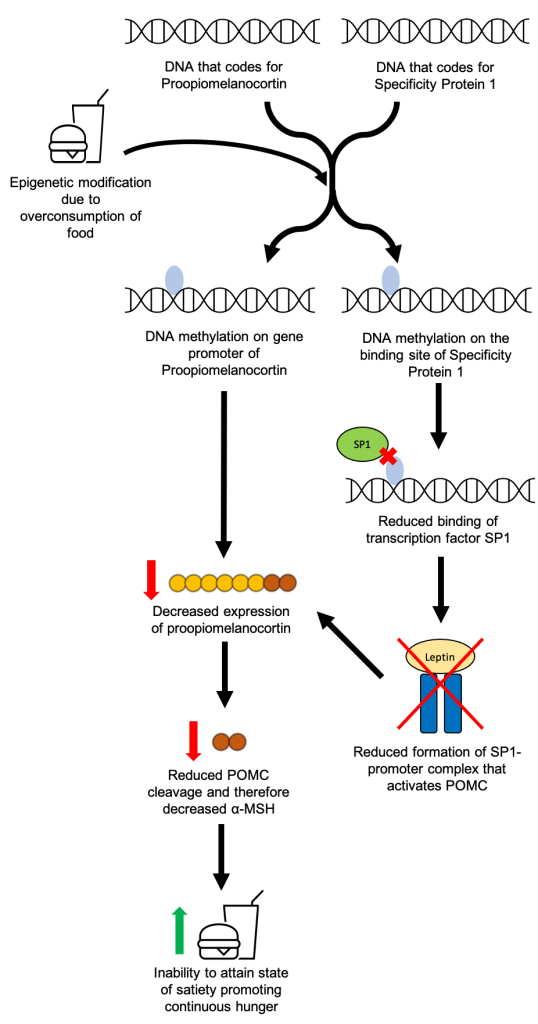What Triggers Overeating?
Here, we will focus on two triggers of overeating. The first approach involves the down regulation of the hormone leptin which plays an integral role in appetite regulation. The second approach explores the reward pathway and how it leads to food addiction.
The hypothalamus is the main appetite regulatory centre as it processes the response of several appetite regulatory hormones such as leptin, which is secreted by adipose tissue and promotes satiety, and ghrelin, which is secreted in the stomach and promotes hunger.
Since our research question focuses on adipose tissue, we will focus on leptin. Adipose tissue does not only serves as a storage depot for fat, but it is an endocrine organ as well and is capable of secreting leptin. The effect of increased levels of leptin ultimately reduces appetite leading to a decrease in the intake of food.

However, epigenetics is reported to have the ability to influence the responsiveness of leptin. Proopiomelanocortin (POMC) is a precursor polypeptide that is cleaved to give rise to a number of peptide hormones including α-melanocyte-stimulating hormone (α-MSH), one of the many hormones that promote satiety (11). POMC is expressed by POMC neurons that are located in the arcuate nucleus of the hypothalamus, and is targeted by leptin. A decrease in the expression of POMC or its subsequent hormone α-MSH is highly correlated with weight gain and obesity due to the feeling of increased hunger (12).
Therefore, lifestyle factors such as continuous overconsumption of food could lead to epigenetic modifications, specifically DNA methylation, at the POMC gene promoter resulting in a lower expression of POMC promoting continuous hunger and food intake (Figure 7) (12). Furthermore, hypermethylation at the binding site for transcription factor specificity protein 1 (SP1) blocks the formation of the SP1-promoter complex that mediates the effect of leptin on the expression of POMC, further promoting hunger as leptin can no longer promote the release of POMC (Figure 7) (13).

The second trigger of overeating involves the mesolimbic reward pathway that is responsible for our ‘food cravings’ or ‘food addiction’. The inability to control how much and how frequently we eat triggers a vicious cycle that leads to food addiction and overeating.
The intake of food is known to activate the mesolimbic reward pathway resulting in the release of dopamine and thus feelings of satisfaction and pleasure. Ghrelin, which is produced in the upper regions of the stomach, promotes hunger and food consumption. Its receptors are found in the ventral tegmental area (VTA) – a group of neurons in the brain that have an important role in the reward pathway as it triggers the release of dopamine from the nucleus accumbens (NA) (14).
However, the release of dopamine can lead to consumption reinforcement, or excessive food seeking behaviour, as the reward pathway plays a role in the cognitive process behind motivation salience (14). This rewarding attribute that the intake of food possesses, along with consumption reinforcement, results in the ‘craving’ many of us experience that is difficult to control and can easily overcome our satiety.
Incentive salience of overeating is driven by the release of dopamine from the nucleus accumbens which encourages the orbitofrontal cortex of the brain, which is involved in decision making, to act in a compulsive manner and seek out food. The release of dopamine can be attributed to the hippocampus and amygdala, the memory centers of the brain, that recalls the pleasure and satisfaction of eating. This compulsive behavior can overpower the self-control process modulated by the prefrontal cortex and cingulate gyrus leading to the spontaneous decision to eat (14). Moreover, overtime, our dopamine receptors could gradually become insensitive, or down-regulated, which results in a greater consumption of food to experience the same feeling of satisfaction (14).

Summary:
The activation of POMC is a precursor polypeptide that is targeted by leptin with the ultimate goal of increasing satiety. Epigenetics, via DNA methylation inhibits the production of POMC which results in a decrease in the hormone a-MSH. A decrease in a-MSH makes it difficult for us to reach a state of satiety, and thus we will continuously be hungry.
The mesolimbic reward pathway is responsible for “food cravings”. Essentially, incentive salience, which is triggered by our memory, is able to overcome our self-control and fulfill our need to eat. As a result, the pleasures from eating (via dopamine) can make us eat despite not being hungry.
Recent Comments